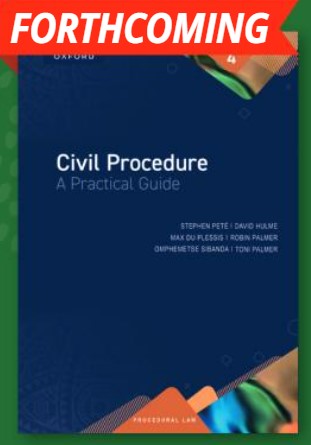
Civil Procedure: A Practical Guide 4e
Civil Procedure: A Practical Guide 4e off ers an exceptionally lucid, concise introduction to the theory and practice of civil procedure in South African law. The text addresses the procedures of the District and Regional Magistrates’ Courts, High Courts, Supreme Court of Appeal, Constitutional Court and Small Claims Court. In addition to discussion of substantive theory, the text provides valuable guidelines, and numerous diagrams and precedents, that support comprehension and practical application of the subject matter. This fourth edition text is revised and updated to address the many legal developments that have occurred within the recent period. Civil Procedure: A Practical Guide 4e serves as core material for courses in civil procedure within the LLB degree programme. It is also a useful first reference for candidate attorneys, pupil advocates, legal practitioners, magistrates and judges. New to this edition: The fourth edition text is thoroughly revised and updated to address the many signifi cant developments that have occurred within the recent period.
Key developments include the following:
• The operation of the Legal Practice Act 28 of 2014, and its implications for, inter alia, the distinction between Attorneys and Advocates.
• The introduction of mediation as a dispute resolution mechanism, which must be considered in the pleadings of all litigation matters as an alternative course of action.
• The introduction of the Judicial Case Management system into the High Court procedural system.
• Changes to the time limits that relate to inspections, examinations and expert testimony in the High Court.
• Changes to procedures that follow a witness being served with a subpoena duces tecum in the High Court.
• In both the High Court and the Magistrates’ Courts, signifi cant changes to procedures for Summary Judgment, the rescission of default judgments, and execution against the primary residence of a judgment debtor, as well as changes to the Rules that address interim relief in matrimonial matters and the representation of parties.
• Amendments to the Magistrates’ Courts Act, aff ecting consent to jurisdiction, the defi nition of ‘court day’, and exceptions and applications to strike . The text discusses the implications of the increasing use of digital technologies in civil procedure, and off ers a new, short chapter relating to international civil procedure trends that impact the South African civil procedural system. Table of contents Stage One Before litigation
• Part One Preliminary questions
• Chapter A: Cause of action
• Chapter B: Locus standi
• Chapter C: Jurisdiction
• Part Two Pre-litigation issues
• Chapter A: Demand
• Chapter B: Calculation of time limits
• Chapter C: Service of legal documents
• Chapter D: Action or application?
• Stage Two Litigation
• Part One Applications
• Chapter A: General principles
• Chapter B: ‘On notice’ applications
• Chapter C: Ex parte applications
• Part Two Actions • Chapter A: Pleadings
• Chapter B: Pre-trial procedures
• Chapter C: Trial
• Chapter D: Judgment, interest and costs
• Stage Three After litigation
• Part One Appeals and reviews
• Chapter A: Appeals
• Chapter B: Reviews
• Part Two Debt collection procedures
• Chapter A: Writs and warrants of execution
• Chapter B: Section 65 procedure
• Chapter C: Administration orders
• Stage our Additional procedures
• Chapter A: Settlement
• Chapter B: Provisional sentence
• Chapter C: Interim relief pending judgment
• Chapter D: Arrest tanquam suspectus de fuga
• Chapter E: Multiple parties and actions
• Chapter F: Interdicts
• Chapter G: Drastic procedures
• Chapter H: Declarations of rights and stated cases
• Chapter I: Small Claims Court procedures
• Chapter J: Other civil courts
• Annexures
• A: Alternative dispute resolution in civil practice • B: Impact of the National Credit Act and the Consumer Protection Act on Civil Procedure • C: Diagrams • D: Precedents • E: Citations • F: Short form, particulars of claim
